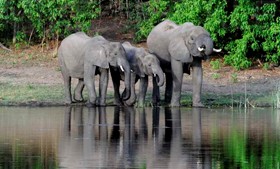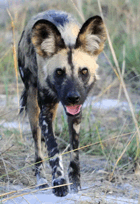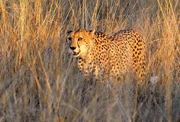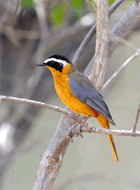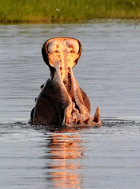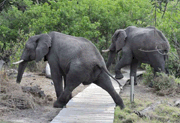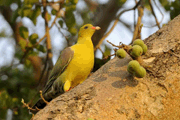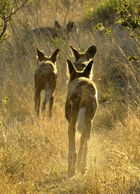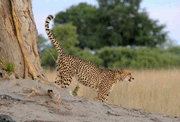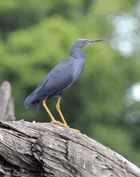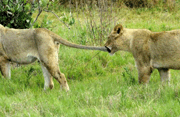Mike Mockler Botswana |
BOTSWANA DELIVERS YET AGAIN In fact, leopards were seen in all three of the areas visited, a total of six leopards in all. These included a pair mating (a rarely-seen event) and a mother and her cub sprawled together along a branch. The mother is Selonyana (“little girl” in the local language), who has been one of Mike’s favourite leopards ever since he first saw her as a youngster. Lions were also seen throughout the tour. These included a large pride of 16 which the group stayed with one afternoon as they stalked prey through thick bush – a fascinating chance to observe their hunting strategy. There were also entertaining, playful cubs and a magnificent male who spent some time walking and calling, occasionally stopping to mark his territory. On several nights, while in camp, it was possible to hear lions calling, surely one of nature’s most thrilling sounds. Male cheetahs were encountered at two of the camps. One of them was extremely relaxed as he patrolled his territory, scent-marking regularly and posing repeatedly for photographs in gorgeous light. African wild dogs are a huge attraction, not surprisingly as they are one of the world’s most endangered large carnivores and, sadly, now rare or extinct throughout much of their former range. They display remarkable loyalty and altruism towards each other and possess amazing hunting prowess. At one sighting, a pack of 18 (including 9 puppies), confronted two breeding herds of elephants, standing their ground in defence of their pups as the elephants almost surrounded them. On the following morning, this pack was found again, just after they had killed an impala and a fully-grown greater kudu, the latter a testimony to their hunting capabilities. Another exciting encounter was when a smaller pack was followed as they raced through the bush, hunting in golden evening sunlight. There were many sessions with other “mega-fauna” such as buffalos, hippos, spotted hyenas (including small pups), giraffes and numerous antelope species. When designing the itineraries, Mike is always mindful of scarce or “difficult” species such as sable antelope, roan antelope and spotted-necked otter, all of which were recorded on this tour. Elephants were seen at close range on several occasions, including a sequence when a herd of 60+ swam across a river and hauled out on the river-bank beside the group’s two vehicles. Elephants were also in camp and, during one night, Mike was woken by the sensation of being out at sea. Not only was his bed moving from side to side but the wooden floor was doing likewise. A large bull elephant was just outside his tented chalet and, each time the elephant reached up for some succulent leaves, he leaned against the wooden decking that formed the base of the room. Rain showers triggered off the births of many young animals: each day there were more tiny impalas, tsessebes, wildebeest and warthogs. There were also wonderful skies and memorable sunsets, not to mention some fabulous light for photography. Although, there were too many other highlights to list here, one certainly merits a mention, even though Mike did not witness it himself. A yellow mongoose, one of the smaller mongooses, was observed and photographed trying to work out how to attack a fully grown boomslang, one of Africa’s most beautiful and venomous snakes. Bird-watching was outstanding with all the local breeding birds in their attractive breeding plumage, singing, courting, nest-building and feeding young. A flock of over 50 usually scarce and elusive white-backed ducks was impressive, as were the swirling flocks of southern carmine bee-eaters near their nest-colony. Interestingly, these birds had excavated their nest-tunnels in level ground and not in a bank or cliff, as is usually the case. All the so-called “Okavango Specials” were seen, including lesser jacana, slaty egret, coppery-tailed coucal, chirping cisticola, swamp boubou and brown firefinch. Though not restricted by any means to the Okavango, Pel’s fishing owl is always a great bird to see and some of the group struck lucky with this lovely species. Migration is a dramatic occurrence and each day provided a new cast. On some days migrant birds were everywhere: Steppe eagles, Wahlberg’s eagles, yellow-billed kites, woolly-necked storks, woodland kingfishers, broad-billed rollers, carmine bee-eaters, blue-cheeked bee-eaters, European bee-eaters, red-backed shrikes, lesser grey shrikes, and a whole range of attractive cuckoo species. There were also familiar friends from home: osprey, European hobby, European swift, common cuckoo, spotted flycatcher, willow warbler and thousands upon thousands of European, or barn, swallows. Not only does Mike select the best areas for wildlife potential, he also requests his favourite local guides. Their knowledge of the wildlife in their area is exceptional, as are their sharp eyes. Most impressive of all, however, is their ability to spot animals tracks while they are driving a Land Rover over rough terrain! Their tracking skills are incredible and many great sightings come about because of the guides’ ability to notice, identify and interpret the signs of the bush. Mike and his group owe much to them. |
|
